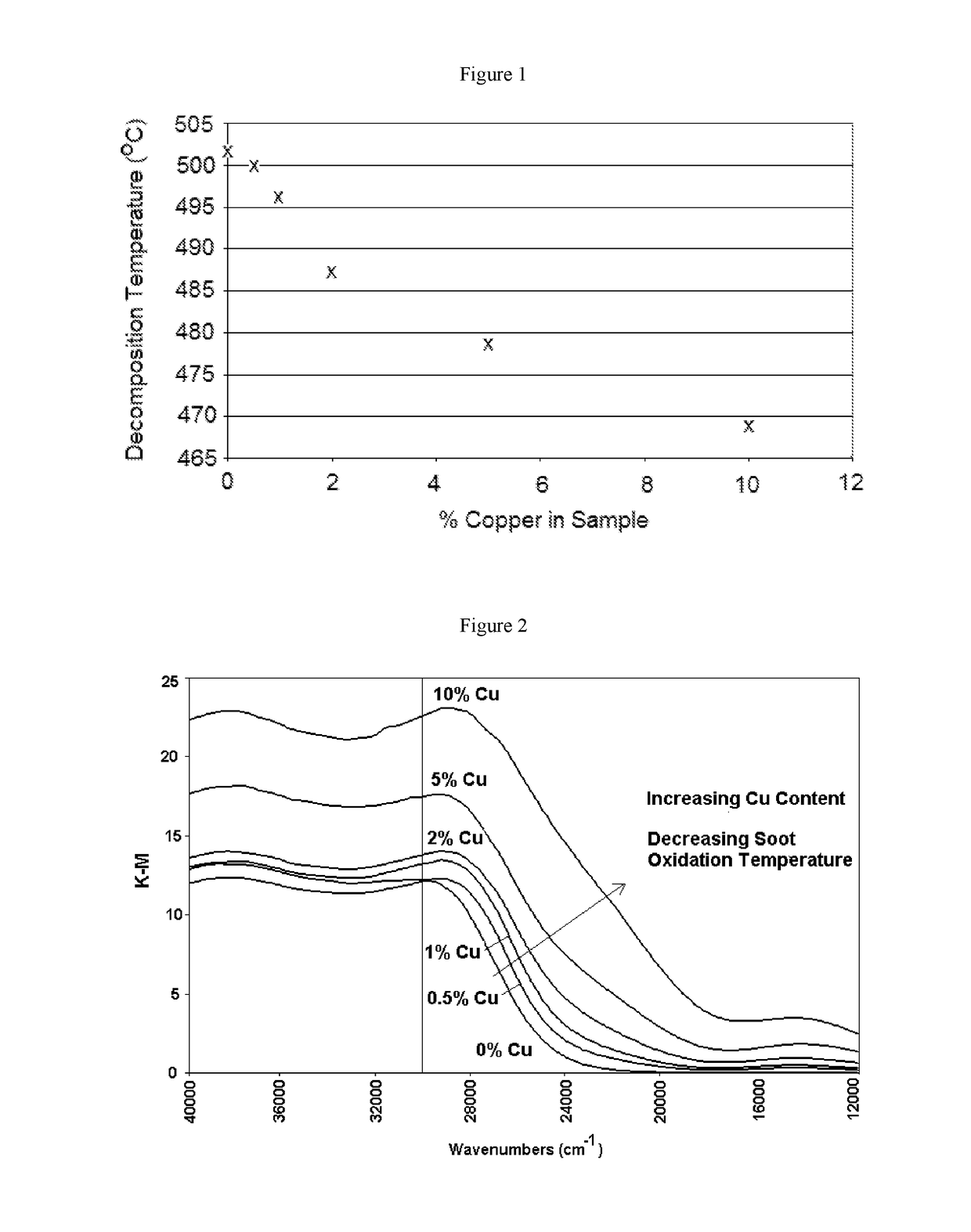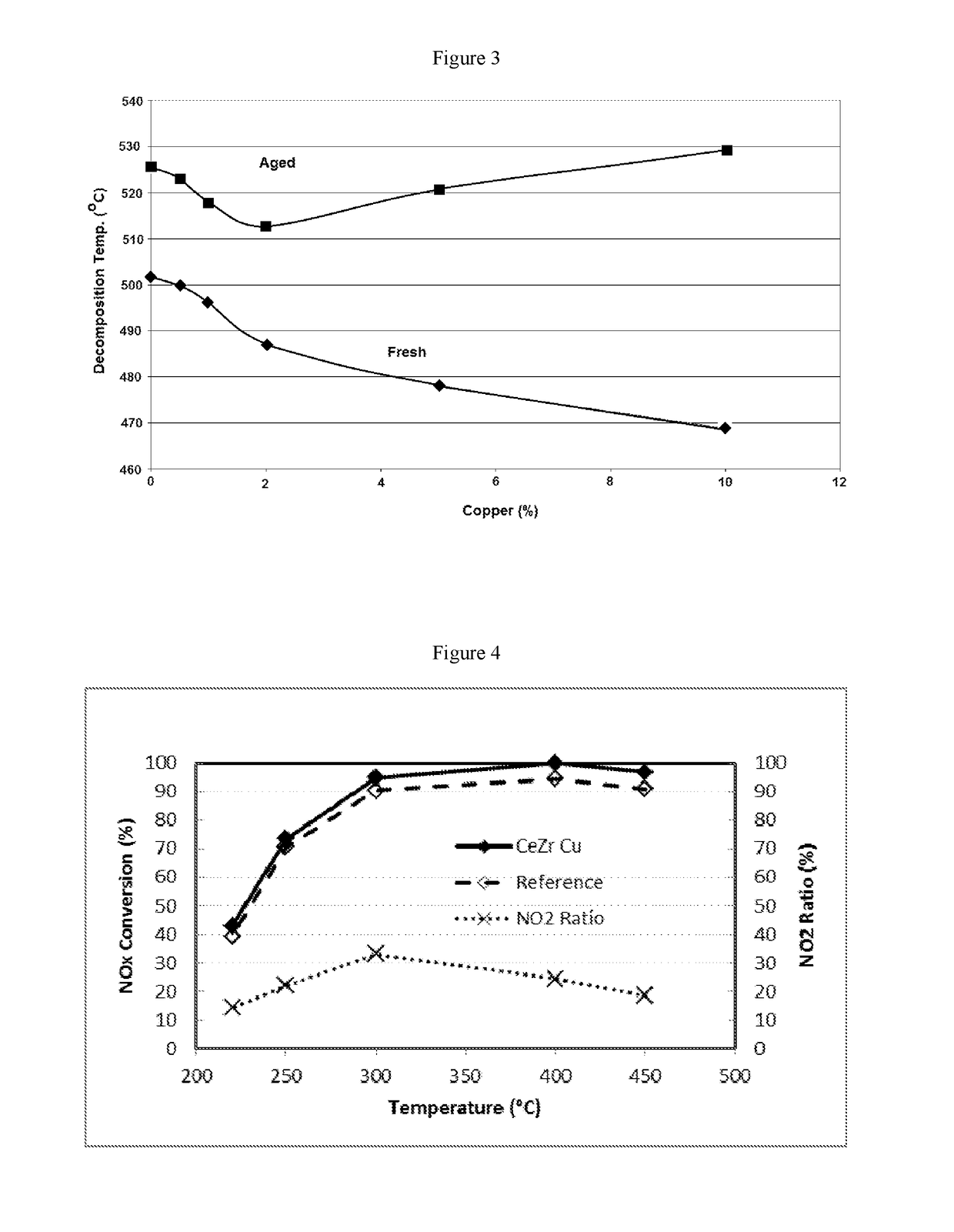Catalytic filter having a soot catalyst and an scr catalyst
a catalytic filter and catalyst technology, applied in the field of catalytic filters, can solve the problems of difficult to efficiently convert into more benign substances, difficult to reduce the back pressure across the filter, and relatively high emissions of exhaust gas particulate matter, so as to reduce the complexity, size and cost of the exhaust gas treatment system, and reduce the effect of soot combustion temperatur
- Summary
- Abstract
- Description
- Claims
- Application Information
AI Technical Summary
Benefits of technology
Problems solved by technology
Method used
Image
Examples
example 1
[0103]Samples 1-6 were prepared by applying a washcoat comprising CeZr and various amounts of Cu onto the surface of an inert substrate as shown below. Sample 7 was prepared by applying a washcoat comprising CeZr and 5 wt % Fe onto the surface of an inert substrate. Samples 2-8 did not contain a zeolite. The samples were dried, and then calcined at 500° C. for 1 hour.
Cu LoadingOn SootSampleZeoliteSoot CatalystCatalyst1NoneCeZr 0%2CeZr—Cu0.5%3CeZr—Cu 1%4CeZr—Cu 2%5CeZr—Cu 5%6CeZr—Cu 10%7CeZr—Fe 5%
[0104]Each of the samples had about 10% soot added onto the surface of the catalyst.
[0105]The samples were analysed by thermogravimetric analysis (TGA) on a TA Q600 TGA to determine the soot combustion properties starting at a temperature of about 20° C. using a temperature ramp of 20° C. / min to 600° C. in flowing air at 80 ml / min at 20 ml / min to determine the amount of soot that was combusted. Samples 1-6 were also analysed by UV / Visible spectroscopy using a Perkin Elmer Lambda 650s wi...
example 2
[0109]Samples from Example 1 were aged at 800° C. for 16 hours. The samples were analysed by thermogravimetric analysis (TGA) and UV / visible spectroscopy as described in in Example 1.
[0110]The table below shows the effect of copper loading on the peak oxidation temperature of the soot catalyst in aged soot catalyst. CeZr with a 2% Cu loading exhibited the lowest peak soot oxidation temperature.
PeakOxidation TempSample(° C.)8Aged CeZr 0% Cu5269Aged CeZr 0.5% Cu52310Aged CeZr 1% Cu51811Aged CeZr 2% Cu51312Aged CeZr 5% Cu52113Aged CeZr 10% Cu52914Aged CeZr 5% Fe555
[0111]All aged samples containing Cu in any amount were more effective at reducing the oxidation temperature than aged samples comprising 5% Fe. Aged samples containing 0.5-5% Cu were more effective at reducing the oxidation temperature than aged samples comprising 0% Cu.
[0112]FIG. 3 demonstrates that there are differences in the catalytic activity between fresh and aged samples and 2% and 10% copper loadings provide the lowe...
example 3
[0114]The ability of fresh and hydrothermally aged catalyst was evaluated on an engine bench test under passive (engine at 3000 rpm with catalyst at 490° C.) and active (exhaust flow of 100 kg / hr with catalyst at 630° C. for 12 minutes) conditions.
[0115]A reference catalyst comprised Cu-CHA at a loading of 0.81 g / in3. A catalyst of the invention comprised Cu-CHA at a loading of 0.81 g / in3 and CeZr+Cu (2 wt %) at a loading of 0.1 g / in3. FIG. 4 shows the % NOx conversion at temperatures from about 225° C. to about 450° C. The catalyst comprising both Cu-CHA and CeZr—Cu (2 wt %) provided higher NOx conversion than the reference sample that did not contain CeZr—Cu. The NO2: NOx ratio was between about 15% and about 35% over this temperature range. These results demonstrate that the presence of the required soot catalyst in a mixture with an SCR catalyst does not have a negative impact on the performance of the SCR catalyst.
[0116]The regeneration efficiency of the catalyst determined und...
PUM
| Property | Measurement | Unit |
|---|---|---|
| Percent by mass | aaaaa | aaaaa |
| Percent by mass | aaaaa | aaaaa |
| Fraction | aaaaa | aaaaa |
Abstract
Description
Claims
Application Information
 Login to View More
Login to View More - R&D
- Intellectual Property
- Life Sciences
- Materials
- Tech Scout
- Unparalleled Data Quality
- Higher Quality Content
- 60% Fewer Hallucinations
Browse by: Latest US Patents, China's latest patents, Technical Efficacy Thesaurus, Application Domain, Technology Topic, Popular Technical Reports.
© 2025 PatSnap. All rights reserved.Legal|Privacy policy|Modern Slavery Act Transparency Statement|Sitemap|About US| Contact US: help@patsnap.com


